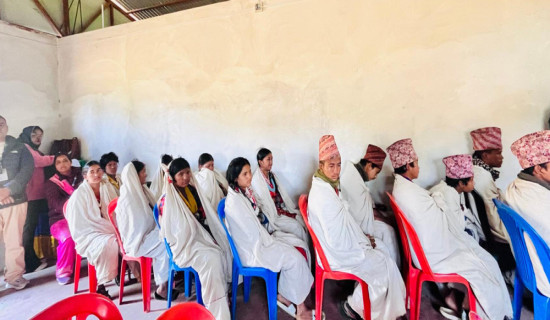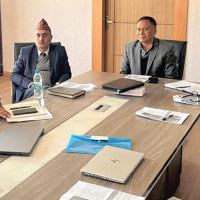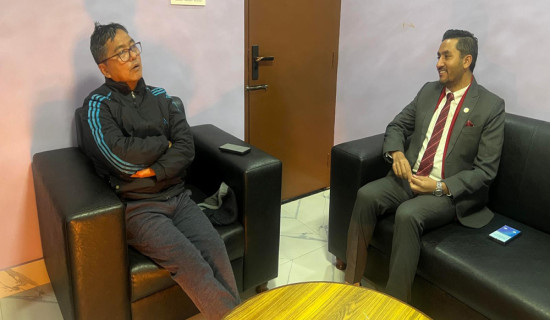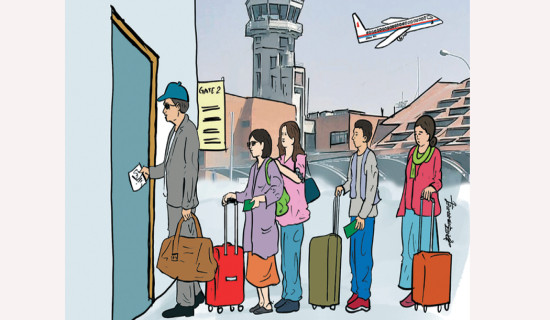- Wednesday, 7 January 2026
Festive Journeys Face Roadblocks
As Dashain approaches, a massive exodus of people from the Kathmandu Valley is expected, with millions heading home to their ancestral homes, leading to huge traffic congestion on the highways. The annual ceremony of going back home is accompanied by an old foe: risky roads. Dashain coincides with the monsoon's lingering wrath. Landslides scar highways, washed-out stretches disrupt travel, and pothole-ridden surfaces expose negligence. Workers have left repairs incomplete, and rains refuse to ease. On Tuesday alone, landslides or floods completely blocked nine nationwide highways. A landslide buried the route at Jhywang Khola near the Mugling–Naubise road section and stopped traffic in both directions. This is the backdrop in which families crowd buses, jeeps, and private vehicles to celebrate together. The state is responsible for ensuring its safety, yet government agencies enter this annual migration unprepared.
When celebration turns to tragedy, Dashain has often become a mourning season in recent years. The festival that symbolises triumph and renewal frequently carries the grief of road tragedies. Last year, on Maha Ashtami, a jeep in Palpa veered off a rain-damaged road and plunged nearly 100 metres into a gorge, killing six members of the same family—grandparents, parents, and children. The previous day in Dang, an overloaded auto-rickshaw carrying a family for Dashain shopping overturned, killing a mother. On September 28 last year, a terrifying landslide at Jhyaple Khola in Dhading killed more than 35 people, just four days before Ghatasthapana. These incidents reveal the lethal mix of fragile roads, overcrowded vehicles, and neglected maintenance.
Officials at the Department of Roads claim they will fill potholes and cracks before September 26. Yet they admit that relentless rainfall keeps undoing their work. "The very day we fill a pothole, the rains wash it open again," they concede. The numbers reflect the fragility. Nepal counts 618 highways and rural roads. Nine remain entirely blocked, 328 allow only one-way passage, and 281 permit smooth two-way traffic.
Risky journey
For most Nepalis, travel remains non-negotiable. They will set out regardless of odds, seeking blessings, reuniting with family, and keeping traditions alive. Their journey demands both devotion and endurance.
Dashain promises joy, but the "great homecoming" now carries danger. Unless officials turn words of repair into action, this year's celebrations may again echo with sorrow.
One scene repeats from Kathmandu's crowded intersections to the hills' winding highways and the villages' dusty trails: buses packed beyond capacity, passengers clinging to rooftops, and ticket counters swamped by desperate crowds.
Every traveller shares the same goal—reaching home in time for Tika or spending the holiday with loved ones. Yet the urgency to leave often pushes passengers into unsafe situations. As festival crowds surge, national highways and narrow rural roads see a spike in accidents.
Road safety experts blame the government and transport entrepreneurs for failing to prevent these tragedies. This year, citing Gen-Z protests, authorities did not open advance ticket booking. Usually, operators open ticket sales only a week before Dashain, and within two days, they sell out. Thousands then scramble for alternatives, forced to stand in aisles, hang from doors, or perch on rooftops—transforming vehicles into ticking time bombs.
Ignorance of safety
Dashain is a season of profit. They force buses to run multiple daily trips, push drivers to exhaustion, and bring back old, unfit vehicles that should have been scrapped years ago. Overcrowding, reckless speeding, and fatigued drivers create a perfect recipe for disaster.
Road safety activists argue that the government and transport entrepreneurs are to blame for failing to ensure safe travel. If officials opened ticket sales a month earlier, passengers could travel calmly. Instead, tickets vanish within days of sales opening, and people cram into unsafe vehicles like pickles in a jar. How can accidents not follow?
Dashain, Nepal's most cherished celebration, should embody family, tradition, and blessings. Yet for too many, it carries fear—the haunting possibility that a loved one may never arrive home.
Each year repeats the cycle: joy on one side, funerals on the other. The unanswered question lingers—will the country ever make its most fantastic festival truly safe?
Road awareness
Festive surges in traffic bring sharp rises in accidents. The link is undeniable: more traffic means more risk. Safety requires shared responsibility among traffic police, volunteers, drivers, passengers, and government agencies. Yet every Dashain exposes Nepal's weak road infrastructure and fragile safety systems.
Driver negligence fuels accidents, but poor road conditions remain the bigger culprit. Of Nepal's 85,000 kilometres of roads, the Department of Roads has built only 27,000–28,000, many below engineering standards. Local authorities built the remaining two-thirds without proper technical norms, and these crumble under festival traffic.
The problem lies not in design but in neglect. Unrepaired landslides, open drainage, missing barriers, inadequate signposts, and pedestrian-unfriendly layouts create hazards. Despite billions spent, highways like Prithvi Highway face annual blockages. Pedestrians, cyclists, and motorcyclists remain highly vulnerable because sidewalks, cycle lanes, zebra crossings, and protective railings barely exist.
The Sindhuli–Bardibas BP Highway illustrates the issue. Japan built it for small agricultural vehicles, yet today it carries heavy trucks and buses beyond its 4.75-metre design. Experts recommend at least 7 metres for safe traffic flow. Last year, floods blocked more than 20 kilometres of this highway, making it impassable during the monsoon and festival season.
Weak driver accountability worsens the crisis. Nepal lacks systems to monitor driving hours or ensure vehicle condition. Most drivers are young and inexperienced, and competition often overrides caution, risking lives.
Technological tools could help. GPS-based tracking, digital driver records, and automated traffic management can enforce discipline and improve safety.
Nepal's roads are full of hazards, which intensify during festive times with more traffic. The high rate of accidents is caused by a lack of maintenance of infrastructural facilities, lax enforcement of regulations, and negligence on the part of everyone involved. Government agencies, civil society organisations, and citizens must collaborate to ensure safe highways.
(The author is a journalist at The Rising Nepal.)
















